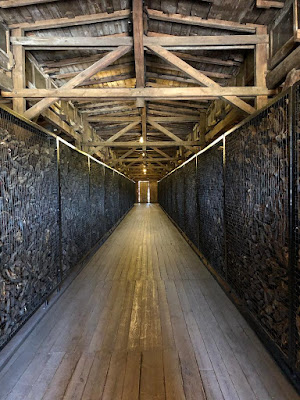Poland Pilgrimage
by Talia Hirsch, 11th
grade, NJ
 |
| The Sages of Lublin Yeshiva |
We
started off the day at the esteemed Sages of Lublin Yeshiva. The yeshiva was in
existence from 1930-1940 and it was one of the most prestigious and competitive
yeshivot in the world. Rabbi Meir Shapiro, the leader of the yeshiva, trained
the elite there so they became teachers knowledgeable in the Torah and able to
teach it well by learning personal skills. It was in Lublin because it was the
center of Torah scholarship in Europe. Meir Shapiro had to raise a lot of money
for the yeshiva. Money was used for all the students needs such as: room,
board, studies, etc. because the students did not pay to go. Secular Jews
donated a lot of money.
 |
| the beit midrash in the Lublin Yeshiva |
The דף יומי (daf yomi)-
one page of Talmud each day was created at the Lublin Yeshiva and is still used
today. The method is to ensure everyone in the world is on the same page on the
same day. It takes 7 1/2 years to complete the whole Babylonian Talmud using
this method. To get into the yeshiva you had to memorize 400 pages of Talmud
ahead of time and you were tested. You had to be a scholar before you got in.
The yeshiva also included a library with 25,000 books and a model of the Beit
Hamikdash. When Nazis came and took overtook it, they made the men put all the
books outside and the Nazis had a book burning that lasted 3 days. Before we
left we studied a page of Talmud from Tractate Ketuvot with Rabbi Sykes in the
yeshiva, it was very interesting.
 |
| Majdanek |
Next we went to the concentration camp
Majdanek. Death camps were in Poland because the largest population of Jews
were in Poland and it is in the center of Europe. Poland’s flat land made it
easy to lay down rail roads which were used to transport people easily to the
camps. Majdanek opened in the summer of 1941, it was
originally for prisoners of war. The majority of people that came and that were
murdered at the camp were actually Poles. The first Jews came in October 1941.
It was also the first camp to be liberated in July 1944. The building to the
right when you first walk in the camp was a sanitation building and also
contained the first gas chamber.
 |
| barracks containing tens of thousands of shoes from prisoners at Majdanek |
Then the buildings along the road were used
for holding the possessions taken from the prisoners who entered. The Germans
who ran the camp used Jewish tomb stones to pave the road. This was very hard
to see because tomb stones are very sacred and using them as a road is
repulsive. There is a statue with three eagles on top that represent the Third
Reich. The prisoners were forced to salute the statue as they passed so the
prisoners came up with a solution instead of saluting the Third Reich: the
prisoners would dig holes under the statue and bury ashes of their family or
friends and when the guards would make them salute they would be saluting their
loved ones. This story was very meaningful and showed that the prisoners were
still witty even through terrible circumstances.
 |
| fragment of a road the Nazis paved with Jewish tombstones |
 |
| statue of eagles at Majdanek that prisoners secretly saluted their comrades |
The crematorium building was
split into seven rooms, all used to dismantle the bodies, search them, and then
cremate them. The thing at the camp that really hit me the hardest was the huge
mound of ashes of the prisoners, under a large cement dome. It was crazy to
see.
Going to the yeshiva and the camp showed two
very different sides of the Jewish people, from life to death.
 |
| crematoria |
 |
| a memorial with an enormous pile of human ashes under a dome |








No comments:
Post a Comment